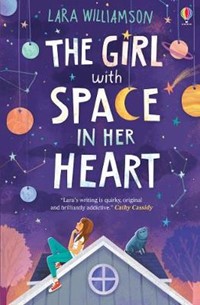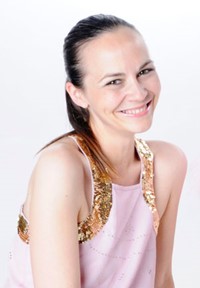Lara Williamson


About Author
Lara Williamson writes brilliant books that will make you laugh and sometimes they might make you cry. Her other books, A Boy Called Hope, The Boy Who Sailed the Ocean in an Armchair and Just Call Me Spaghetti-Hoop Boy, have all been shortlisted for awards.
Lara was born and studied in Northern Ireland before moving to London, where she now lives with her family. She loves writing poems, seeing balloons fly into the sky and blowing on dandelion clocks. And she was so happy to discover that she's made of stardust that she keeps telling anyone who will listen.
Interview
THE GIRL WITH SPACE IN HER HEART
USBORNE
AUGUST 2019
THE GIRL WITH SPACE IN HER HEART, the latest title from award-winning author LARA WILLIAMSON, follows space-obsessed Mabel Mynt and her antagonistic sister, 'Terrible Topaz', as they try to navigate life without their father and to decide if their mother's new boyfriend, 'Galactic Gavin', has their mum's best interests at heart.
Author LARA WILLIAMSON tells us about this moving and powerful novel about trust, families, and that little bit of stardust in us all, THE GIRL WITH SPACE IN HER HEART:
Q: Can you tell us a little about your writing journey and how you originally came to write for children?
A: Ever since I was a child, I've wanted to write a book. When I was ten, I made the decision I'd get published and set about writing and illustrating my own work. I had hoped this story would be the one to get me published but ten-year-old me never got beyond the first few chapters so I gave up (although luckily, I never gave up completely).
My first paid writing job was at a teen magazine where I worked on features and then on the beauty pages. It was so exciting writing for this age group that I've never wanted to stop. Maybe it's also because part of me is a child inside my head.
Q: Your books often follow a powerful emotional journey for your characters; what draws you to exploring these kinds of stories?
A: I can't imagine writing anything but a story with an emotional heart, because that's essentially who I am. Below the surface, I feel everything really deeply and try to channel that into my work.
Another thing that's really important to me, and something I try to explore in my writing, is hope. Without feeling hope I don't think I could write anything at all. Hope is the ribbon that is woven through each and every one of my books. No matter how difficult things are there is always hope - I truly believe that and it's the draw that keeps pulling me back to writing these stories.
Q: Your earlier titles all have 'Boy' in the title - why did you decide to write about a girl character for this book?
A: I think it just depends on the story and what fits it best. But really, I just tend to go with my gut and let that lead me. In fact, the story I'd written just before I got published with A Boy Called Hope had a strong girl character. And I felt the same would work with The Girl with Space in her Heart and so that's what I went with. The next one might be a boy or a girl. Either way, I love the feeling that anything is possible.
Q: Was it a hard novel to write? How did it compare to others you have written?
A: Each story throws up different issues so I tend to take each one as it comes. They're all different and because of that it's hard to say if any have been more complicated than the others.
I will say though that I think the easiest and quickest one to write was A Boy Called Hope.
Q: In The Girl with Space in her Heart, you follow Mabel Mynt, who has a 'worry suitcase' that is weighing her down. What was the starting point of the story for you?
A: A while ago, my sister gave me a CD which was supposed to help you relax. It had the sounds of waves lapping on a beach and seagulls and a man saying to close your eyes and pack your worries into a box or a chest and lock them in there.
It got me thinking about packing the worries away and then I got to thinking about what you'd do if you had to drag those same worries around with you and how heavy it would be if you couldn't get rid of them.
I still have that CD and put it on from time to time.
Q: We discover during the story that Mabel's father has disappeared. Children's stories often begin with the loss of parents, but yours focus more on the fallout. What draws you to exploring how families can impact on children?
A: Separation and loss are all complex situations in a child's life and can have a huge emotional impact, affecting the child for a long time. So, I try to explore what happens afterwards and how the child will cope going forward.
It's important that the child in the book, despite having a difficult time, realises that things can and will improve and they will grow stronger as a result. Also, although I'm writing the story from one person's point of view, I tend to think that everyone in that particular situation is affected in some way but we don't necessarily hear their side of the story.
Q: Mabel struggles to get on with her prickly older sister, Topaz. Why did you decide to make their relationship so challenging - have you drawn on your own sibling relationship(s)?
A: Yes, their relationship is challenging but I think it's because they're both dealing with their own issues in different ways so when they come together, they clash. But I'm in no doubt that deep down they love each other and would do anything for each other. That's how I feel about family. You might argue and fall out, but you'd do anything for each other.
I'm actually an only child but was lucky enough to grow up with a family around me that treated me as one of their own and to have that experience of siblings has been one of the greatest joys of my life. Did we argue, sure! Would we do anything for each other, yes! And because they're the best, this book is dedicated to my two sisters.
Q: Through the story, we discover that many of the characters have secrets they are not sharing. Why did you want to explore how hiding the truth can affect families and especially children, as well as friendships?
A: This is always a tricky one for me because I suspect some adults might try to protect their children from the truth, if they feel it would hurt them. But then sometimes hiding the truth isn't always the right answer either because the child can be even more confused and mixed up about what's going on. Or they might think something worse is happening because things aren't fully explained to them.
It's that tricky balance that I find interesting and how it can tip either way and that's what I'm trying to explore in the stories.
Q: Space is quite a big theme in the story - are you a stargazer, or did you need to research your facts for the book?
A: I am a stargazer in the fact that I absolutely love looking at the sky. But for me, it's more of an emotional pull. I look up and feel awe at how vast it is and how incredible.
To be honest, there's so much I don't know and I'm not as technical as Mabel is in the book - so I did some research to help me on the subject. At heart though, I'm more about looking up and embracing that magic. I also have a thing for star shapes and have lots of clothing with stars on it and I've even got a Pinterest board called STARS.
Q: Do children contact you about your novels and have you ever followed through on a suggestion they have made?
A: Yes, I do sometimes get letters and I love it when readers take the time to write. A hand written letter is so special and they all find a little home on my fridge so I can see them every day. And if they make a suggestion that would help with a book then I would always keep it in mind because children are amazing and have the best ideas.
Q: What are the best and worst things about being an author?
A: The best part is daydreaming. How amazing to have a job where I can daydream and be anyone or anything I want. I'm only limited by my own imagination.
The worst part, I guess if you could call it worst, is it can be a bit lonely at times. For a large part of the process you're alone and sometimes I miss having company like you'd have at school or in an office. Still, I can't complain because it's the best job ever so there isn't really a worst part at all.
Q: What would your dream writer's shed look like, and where would it be?
A: I do my writing at the dining table so a writer's shed would be a total dream for me. I'd like to have a garden big enough to have a little painted, wooden shed at the back and then I'd fill it with inspirational pictures and quotes. Oh, and there would have to be fairy lights - there always has to be fairy lights because they remind me of stars.
Where would it be? That's an easy one for me. It would be at home. With all my characters - they go in search of something and they tend to find the answers in a special place and that special place is home.
Home is my special place too and there's nowhere else on earth I'd rather be. It's the place where I can close the door and totally relax surrounded by people I love and who love me back. Nowhere else can compare.
Q: What are you writing at the moment?
A: I have a few ideas of what I'd like to do next. I have written a shorter, funny story that I've just edited and I've started another new story as well. In essence, I've got a few things on the go at once.
But with all my stories, I need to feel a really strong emotional connection for me to want to continue with it. Some ideas don't quite work so I abandon them. My computer is littered with half written stories. Thankfully, the right story always comes through in the end.
Q: What do you enjoy doing the most when you're not writing?
A: I tap dance, so that's my favourite thing in the world. I always feel full of joy when I've got my dancing shoes on. There's no better feeling than tired feet and a happy heart. I also have an interest in interiors so you'll often find me searching Pinterest for different fabrics and deciding whether I want Limestone or Mortar paint on my walls.
 The Girl with Space in Her Heart
The Girl with Space in Her Heart
 Just Call Me Spaghetti-Hoop Boy
Just Call Me Spaghetti-Hoop Boy
 The Boy Who Sailed the Ocean in an Armchair
The Boy Who Sailed the Ocean in an Armchair
